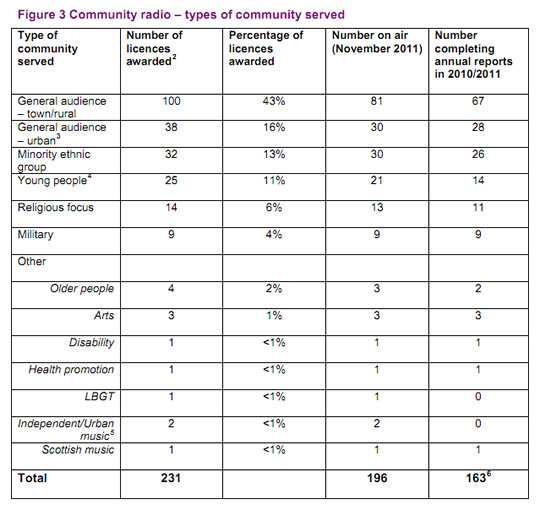Ofcom, the United Kingdom’s broadcast regulator, has released its annual report for April 2012 through March 2013. This paragraph caught my eye:
Over 200 community radio stations are now broadcasting in locations across the UK. Since Ofcom awarded the first community radio licence in 2005, a new station has launched on average every 13 days, each serving a particular community’s needs. Over the past year, Ofcom has awarded new licences in Scotland, Wales and the south-west of England.

A 2011 Ofcom breakdown of community radio stations in the UK.
Note the excerpted paragraph’s emphasis on each station “serving a particular community’s needs.” This is a very different approach from the United States, where both regulatory and statutory law leave the concept of “community” undefined, save for non-profit status, signal reach, and technical rules. Britain incorporates those details, of course, describing community radio as stations that “typically cover a small geographical area with a coverage radius of up to 5km and run on a not-for-profit basis.” But unlike the US, UK community radio license applicants are encouraged to specify specific groups of people for broadcasting service.
So, for example, Ofcom has just authorized a Belfast signal for residents over 55 years of age and another for the “Irish language community, and those with an interest in Irish language and culture within the broader English-speaking community, in the Greater Maghera Area in south County Derry.” At the same time the agency gave the green light to fUSe FM, a service that “will reflect the traditions, language and culture of Ulster Scots in Ballymoney and surrounding areas.”
Back in 2010 the regulator approved a signal in Grays and Thurrock called “SAFE” radio, which aimed “to unite young people from different backgrounds and give them a platform to air their views and promote understanding, tolerance and respect.”
There are licenses for specific kinds of music, for LGBT listeners, for people with disabilities, for “health promotion,” and for the military.
You could argue that this targeted strategy has a down side—limiting possible listeners in a given broadcast area. On the other hand, a 2011 Ofcom report on the economic state of UK community radio noted that stations “targeting a community of interest (rather than a geographic community) reported a higher income than the sector average.”


